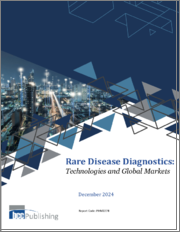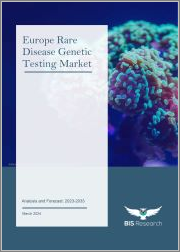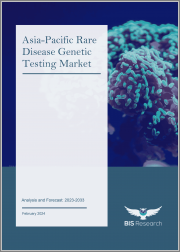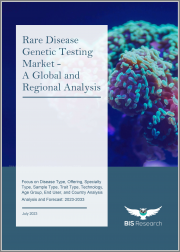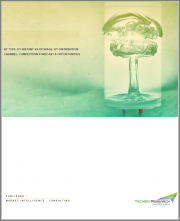
|
시장보고서
상품코드
1370935
희귀질환 유전자 검사 시장 : 세계 산업 규모, 점유율, 동향, 기회 및 예측(2018-2028년) - 질환 유형별, 전문 분야별, 기술별, 최종사용자별, 지역별, 경쟁Rare Disease Genetic Testing Market - Global Industry Size, Share, Trends, Opportunity, and Forecast, 2018-2028 Segmented By Disease Type, By Speciality By Technology, By End User, By Region, Competition |
||||||
세계의 희귀질환 유전자 검사 시장은 2022년에 7억 8,983만 달러로 평가되며 예측 기간 중 견고한 성장이 전망되며 예상 연간 평균 성장률(CAGR)은 8.04%로, 2028년에는 12억 4,963만 달러에 달할 것으로 예측됩니다.
희귀질환 유전자 검사는 희귀질환을 유발하는 유전자 돌연변이나 변화를 진단하는 것입니다. 이러한 질환은 유병률이 낮고 인구의 극히 일부만 앓고 있습니다. 대부분 특정 유전자의 유전자 돌연변이나 변화로 인해 발생합니다. 희귀질환 유전자 검사는 개인의 DNA를 분석하여 증상이나 상태를 유발할 수 있는 이상이나 돌연변이를 찾아냅니다. 이를 통해 정확한 진단, 질환의 근본 원인에 대한 이해, 맞춤 치료 전략을 수립할 수 있도록 돕습니다. 희귀질환 유전자 검사에는 여러 유전자와 유전체 전체를 동시에 분석할 수 있는 차세대염기서열분석기(NGS) 등 다양한 기술이 활용되고 있습니다. 이 기술은 유전자 검사의 효율성과 정확성을 높여 희귀 유전자 변이 검출을 가능하게 합니다.
주요 시장 성장 촉진요인
희귀질환 유병률 증가로 시장 성장 촉진:희귀질환 유병률 증가는 세계 희귀질환 유전자 검사 시장의 중요한 촉진요인입니다. 인구의 희귀질환 유병률은 3.5 - 5.9%로 추정되며, 이는 세계에서 약 2억 6 천만 - 4억 4 천만 명에 해당합니다. 유전학과 희귀질환에 대한 이해가 높아짐에 따라 유전자 검사는 정확한 조기 진단을 위해 필수적인 요소로 자리 잡았습니다. 유전자 검사는 희귀질환과 관련된 특정 유전자 돌연변이를 식별하고, 진단을 확정하고, 표적 치료 계획을 수립할 수 있게 해줍니다. 의료진과 환자들 사이에서 희귀질환에 대한 인식이 높아짐에 따라 정확하고 신속한 진단에 대한 요구가 증가하고 있습니다. 환자와 가족들은 희귀질환이 의심되는 경우 유전자 검사를 받는 경향이 높아 시장 성장에 기여하고 있습니다. 개인의 유전적 체질에 맞는 의료를 제공하는 정밀의료의 개념은 유전자 검사에 대한 수요를 더욱 증가시키고 있습니다.
| 시장 개요 | |
|---|---|
| 예측 기간 | 2024-2028년 |
| 2022년 시장 규모 | 7억 8,983만 달러 |
| 2028년 시장 규모 | 12억 4,963만 달러 |
| CAGR 2023-2028년 | 8.04% |
| 급성장 부문 | 조사 연구소 및 CRO |
| 최대 시장 | 북미 |
맞춤형 의료에 대한 수요 증가로 시장 성장 견인맞춤형 의료에 대한 수요 증가는 세계 희귀질환 유전자 검사 시장에 큰 영향을 미치고 있습니다. 맞춤의료는 유전적 체질을 포함한 환자 개개인의 특성에 맞게 의료를 조정하는 것을 포함합니다. 유전자 정보를 바탕으로 어떤 치료가 가장 효과적일지 예측합니다. 유전자 검사는 희귀질환의 기저에 있는 유전자 변이를 찾아내어 진단을 확정하고 그 원인을 파악하는 데 매우 중요합니다. 맞춤의료는 질병의 근본 원인을 목표로 하기 때문에 유전자 검사는 치료법을 조정하는 데 필수적입니다. 유전자 검사는 희귀질환을 조기에 정확하게 진단할 수 있으며, 증상이 모호하거나 중복된 증상을 가진 질환에 특히 중요합니다. 정확한 진단은 적절하고 효과적인 치료 옵션을 보장합니다. 유전자 검사는 또한 잠재적인 약물 표적을 식별하고, 치료 반응을 예측하며, 치료 선택에 대한 지침을 제공하기 때문에 표준 치료법이 제한적인 희귀질환에서 특히 중요합니다.
인식 제고와 옹호가 시장 성장의 원동력:희귀질환에 대한 인식과 옹호가 높아지면서 세계 희귀질환 유전자 검사 시장의 성장에 기여하고 있습니다. 약 7,000개의 희귀질환이 2,500만-3,000만 명의 미국인들을 괴롭히고 있으며, 이는 인식 증가로 이어지고 있습니다. 옹호 활동은 희귀질환 관리에서 유전자 검사에 대한 인지도를 높이고 검사 서비스에 대한 수요를 증가시킵니다. 인지도 향상과 옹호 활동은 환자, 의료 서비스 프로바이더 및 정책 입안자들 사이에서 유전자 검사에 대한 관심을 증가시킬 것입니다. 희귀질환과 유전자 검사의 중요성에 대한 인식이 확산됨에 따라 환자들은 정확한 진단과 맞춤형 치료를 위해 유전자 검사를 요구하게 될 것입니다. 환자 결과 개선을 위한 조기 진단의 중요성을 강조하는 옹호 활동은 검사 서비스에 대한 수요 증가로 이어지고 있습니다. 옹호 단체, 의료 서비스 프로바이더 및 연구자 간의 협력은 유전자 검사에 대한 접근성과 자금 조달을 개선하여 시장 성장에 기여하고 있습니다.
주요 시장 과제
진단의 복잡성이 검사 문제를 야기한다:희귀질환 진단의 복잡성은 진단의 지연과 오진으로 이어질 수 있습니다. 의료진은 증상의 근본 원인을 파악하는 데 어려움을 겪을 수 있으며, 이는 잘못된 치료와 개입으로 이어질 수 있습니다. 희귀질환은 증상이 고르지 않고 표준화된 진단 기준이 없어 유전자 검사가 어려운 경우가 많습니다. 희귀질환의 유전적 기반에는 여러 유전자와 변이가 관여할 수 있으며, 정확한 돌연변이 식별을 복잡하게 만듭니다. 희귀질환의 유전자 변이를 정확하게 확인하기 위해서는 첨단 검사 기술과 생물정보학 분석이 필요합니다.
제한적인 지식과 인식이 검사 보급을 가로막고 있다: 의료진의 인식이 제한적이어서 희귀질환에 대한 유전자 검사에 대한 검토가 이루어지지 않고 있습니다. 희귀질환의 임상상 및 유전적 프로파일에 대한 지식이 부족하여 유전자 검사가 충분히 활용되지 못하고 있습니다. 제한된 지식으로 인한 오진은 부적절한 치료를 초래합니다. 낮은 인지도는 의료 서비스 프로바이더가 특정 희귀질환과 관련된 유전자 마커를 인식하지 못할 수 있으므로 유전자 검사 선택에 영향을 미칩니다. 낮은 인지도는 또한 희귀질환의 연구 발전과 검사 개발을 늦춥니다.
윤리 및 프라이버시 문제가 검사 보급에 영향을 미치다:윤리 및 프라이버시 문제는 희귀질환에 대한 유전자 검사 도입에 영향을 미칩니다. 유전학적 검사에 대한 사전 동의를 얻는 것은 특히 희귀질환의 경우 복잡합니다. 유전자 데이터에 대한 프라이버시 및 보안 문제는 검사 참여를 방해할 수 있습니다. 유전자 검사로 인해 예기치 않은 결과가 밝혀질 수 있으며, 윤리적 딜레마가 발생합니다. 유전자 데이터는 검사에 동의하지 않은 가족에게도 영향을 미칠 수 있습니다. 윤리적 고려는 문화적, 종교적 신념에 영향을 받기 때문에 신중한 검사 관리가 필요합니다.
주요 시장 동향
소비자 직접 검사(DTC)의 성장: 세계 희귀질환 유전자 검사 시장에서 DTC 검사의 성장은 가계 및 건강 형질과 같은 다른 유전자 검사 분야에 비해 상대적으로 제한적이지만, DTC 검사는 소비자에게 유전적 정보를 제공하고 희귀질환 관련 마커를 식별할 수 있습니다. 마커를 식별할 가능성이 있습니다. DTC 검사는 희귀질환에 국한되지 않고 일반적인 유전학 및 건강에 대한 인식을 높이고, DTC 검사는 질병과 관련된 희귀한 유전자 변이를 식별할 수 있습니다. 일부 기업은 희귀질환의 연구와 발견을 돕기 위해 유전자 데이터를 연구 데이터베이스에 제공하는 옵션을 제공합니다. 윤리적 문제와 규제 감독은 DTC 검사의 정확도와 영향에 영향을 미칩니다.
부문별 인사이트
질환 유형별 인사이트내분비 및 대사 분야가 2022년 희귀질환 유전자 검사 시장을 주도할 것으로 예상되며, 향후에도 지속적인 성장이 예상됩니다. 이 범주의 희귀질환은 대부분 호르몬 생산과 대사에 영향을 미치는 돌연변이를 동반하는 명확한 유전적 기반을 가지고 있습니다. 유전자 검사는 조기 진단과 중재를 돕습니다. 유전자 정보는 맞춤 치료 계획을 안내하고 특정 유전자 변이를 표적으로 삼아 결과를 개선할 수 있습니다.
기술별 인사이트차세대 시퀀싱(NGS)이 2022년 희귀질환 유전자 검사 시장을 장악하고 계속 성장할 것. NGS는 유전자 검사에 혁명을 일으켜 속도, 경제성, 정확성, 대규모 유전자 데이터 세트 분석을 제공합니다. 희귀 유전자 돌연변이 식별을 돕고 진단과 치료의 정확도를 높입니다.
전문분야별 인사이트분자 유전학 검사가 2022년 희귀질환 유전학 검사 시장을 장악하고 지속적으로 성장할 것으로 예상됩니다. 분자 검사는 DNA, RNA, 단백질을 분석하여 희귀질환을 진단하고 진행을 모니터링하며 위험을 식별합니다.
최종사용자별 인사이트 2022년 희귀질환 유전자 검사 시장은 연구 및 계약연구기관(CRO)이 주도하고 있으며, 앞으로도 계속 성장할 것으로 예상됩니다. 이들은 유전자 검사를 개발하고, 임상시험을 수행하며, 검사 서비스를 제공합니다. R&D 및 CRO는 희귀질환의 유전적 기초를 연구하고, 치료법을 개발하며, 진단과 관리를 개선합니다.
지역별 인사이트
세계의 희귀질환 유전자 검사 시장은 미국과 캐나다를 중심으로 북미가 주도하고 있습니다. 이들 국가는 유전자 검사 기술의 개발, 채택 및 통합을 지원하는 첨단 의료 인프라를 보유하고 있습니다. 이 지역의 높은 희귀질환 유병률은 인구의 고령화 및 인식의 향상과 같은 요인에 기인합니다. 이 지역의 우수한 의료 환경은 유전자 검사의 성장과 채택을 지원하고 있습니다.
목차
제1장 개요
제2장 조사 방법
제3장 주요 요약
제4장 고객의 소리
제5장 가격 분석
제6장 세계의 희귀질환 유전자 검사 시장 전망
- 시장 규모와 예측
- 금액·수량별
- 시장 점유율과 예측
- 질환 유형별(신경, CVD)
- 전문 분야별(분자, 생화학)
- 기술별(NGS, PCR 기반)
- 최종사용자별(연구소·CRO, 병원·클리닉, 진단 연구소)
- 기업별(2022년)
- 지역별
- 제품 시장 맵
제7장 북미의 희귀질환 유전자 검사 시장 전망
- 시장 규모·예측
- 금액·수량별
- 시장 점유율과 예측
- 질환 유형별
- 전문 분야별
- 기술별
- 최종사용자별
- 국가별
- 북미 : 국가별 분석
- 미국
- 멕시코
- 캐나다
제8장 유럽의 희귀질환 유전자 검사 시장 전망
- 시장 규모·예측
- 금액·수량별
- 시장 점유율과 예측
- 질환 유형별
- 전문 분야별
- 기술별
- 최종사용자별
- 국가별
- 유럽 : 국가별 분석
- 프랑스
- 독일
- 영국
- 이탈리아
- 스페인
제9장 아시아태평양의 희귀질환 유전자 검사 시장 전망
- 시장 규모·예측
- 금액·수량별
- 시장 점유율과 예측
- 질환 유형별
- 전문 분야별
- 기술별
- 최종사용자별
- 국가별
- 아시아태평양 : 국가별 분석
- 중국
- 인도
- 한국
- 일본
- 호주
제10장 남미의 희귀질환 유전자 검사 시장 전망
- 시장 규모·예측
- 금액·수량별
- 시장 점유율과 예측
- 질환 유형별
- 전문 분야별
- 기술별
- 최종사용자별
- 국가별
- 남미 : 국가별 분석
- 브라질
- 아르헨티나
- 콜롬비아
제11장 중동 및 아프리카의 희귀질환 유전자 검사 시장 전망
- 시장 규모·예측
- 금액·수량별
- 시장 점유율과 예측
- 질환 유형별
- 전문 분야별
- 기술별
- 최종사용자별
- 국가별
- 중동 및 아프리카 : 국가별 분석
- 남아프리카공화국
- 사우디아라비아
- 아랍에미리트
제12장 시장 역학
- 촉진요인
- 과제
제13장 시장 동향과 발전
- 제품 출시
- 합병과 인수
제14장 PESTLE 분석
제15장 Porter's Five Forces 분석
- 업계내 경쟁
- 신규 참여의 가능성
- 공급업체의 힘
- 고객의 힘
- 대체품의 위협
제16장 경쟁 구도
- Centogene N.V.
- Invitae Corp.
- 3billion, Inc.
- Arup Laboratories
- Eurofins Scientific
- Strand Life Sciences
- Ambry Genetics
- Perkin Elmer, Inc.
- Realm IDX, Inc.
- Macrogen, Inc.
제17장 전략적 제안
KSA 23.11.09The Global Rare Disease Genetic Testing Market was valued at USD 789.83 Million in 2022 and is expected to experience robust growth during the forecast period, with a projected Compound Annual Growth Rate (CAGR) of 8.04% and expected to reach USD 1249.63 Million through 2028. Rare Disease Genetic Testing involves the diagnosis of genetic mutations or alterations responsible for rare diseases. These diseases have a low prevalence, affecting only a small percentage of the population. They are often caused by genetic mutations or alterations in specific genes. Genetic testing for rare diseases analyzes an individual's DNA to identify abnormalities or mutations that may be causing their symptoms or condition. This aids in accurate diagnosis, understanding the underlying cause of the disease, and guiding personalized treatment strategies. Various techniques are used for rare disease genetic testing, including next-generation sequencing (NGS), which allows the analysis of multiple genes or the entire genome simultaneously. This technology enhances the efficiency and accuracy of genetic testing, enabling the detection of rare genetic mutations.
Key Market Drivers
Increasing Prevalence of Rare Diseases Drives Market Growth: The rising prevalence of rare diseases is a significant driver for the global rare disease genetic testing market. The prevalence rate of rare diseases in the population was estimated at 3.5-5.9%, translating to approximately 260-440 million people globally. As understanding of genetics and rare diseases improves, genetic testing becomes crucial for accurate and early diagnosis. It enables the identification of specific genetic mutations associated with rare diseases, confirming diagnoses, and enabling targeted treatment plans. Increased awareness of rare diseases among healthcare providers and patients has led to higher demand for accurate and timely diagnosis. Patients and their families are more likely to seek genetic testing for suspected rare diseases, contributing to market growth. The concept of precision medicine, which tailors medical care to an individual's genetic makeup, further drives the demand for genetic testing.
| Market Overview | |
|---|---|
| Forecast Period | 2024-2028 |
| Market Size 2022 | USD 789.83 Million |
| Market Size 2028 | USD 1249.63 Million |
| CAGR 2023-2028 | 8.04% |
| Fastest Growing Segment | Research Laboratories & CROs |
| Largest Market | North America |
Increasing Demand for Personalized Medication Drives Market Growth: The growing demand for personalized medicine significantly influences the global rare disease genetic testing market. Personalized medicine involves tailoring medical treatment to individual patient characteristics, including genetic makeup. It anticipates which treatments will be most effective based on genetic information. Genetic testing is crucial for identifying genetic mutations underlying rare diseases, confirming diagnoses, and understanding their causes. Personalized medicine aims to target disease root causes, making genetic testing essential for treatment tailoring. Genetic testing enables precise and early rare disease diagnosis, especially important for conditions with vague or overlapping symptoms. Accurate diagnosis ensures appropriate and effective treatment options. Genetic testing also identifies potential drug targets, predicts treatment responses, and guides therapy selection, particularly important for rare diseases with limited standard treatments.
Increasing Awareness and Advocacy Drive Market Growth: Rising awareness and advocacy for rare diseases contribute to the growth of the global rare disease genetic testing market. Approximately 7,000 rare diseases affect 25-30 million Americans, leading to increased awareness. Advocacy efforts raise the profile of genetic testing in managing rare diseases, driving demand for testing services. Increased awareness and advocacy lead to greater genetic testing consideration among patients, healthcare providers, and policymakers. As awareness spreads about rare diseases and the importance of genetic testing, patients seek genetic testing for accurate diagnosis and personalized treatment. Advocacy initiatives emphasize early diagnosis significance for improved patient outcomes, leading to higher demand for testing services. Collaborations between advocacy groups, healthcare providers, and researchers improve genetic testing access and funding, contributing to market growth.
Key Market Challenges
Diagnostic Complexity Poses Testing Challenges: Rare diseases' complexity can lead to delayed or misdiagnosis. Healthcare providers may struggle to identify underlying causes of symptoms, leading to incorrect treatments or interventions. Rare diseases have heterogeneous symptoms and often lack standardized diagnostic criteria, making genetic testing challenging. Rare diseases' genetic basis can involve multiple genes and variants, complicating precise mutation identification. Advanced testing technologies and bioinformatics analysis are required to identify rare disease genetic mutations accurately.
Limited Knowledge and Awareness Hinders Testing Adoption: Limited awareness among healthcare providers hinders genetic testing consideration for rare diseases. Lack of familiarity with rare disease clinical presentations and genetic profiles leads to underutilization of genetic testing. Misdiagnosis due to limited knowledge results in inappropriate treatments. Limited awareness affects genetic testing selection, as providers may not recognize genetic markers associated with specific rare diseases. Limited awareness also slows rare disease research progress and test development.
Ethical and Privacy Concerns Impact Testing Uptake: Ethical and privacy concerns affect rare disease genetic testing adoption. Obtaining informed consent for genetic testing is complex, especially for rare diseases. Privacy and security concerns around genetic data discourage testing participation. Genetic testing may reveal unexpected findings, creating ethical dilemmas. Genetic data may also affect family members who have not consented to testing. Ethical considerations are influenced by cultural and religious beliefs, requiring careful testing management.
Key Market Trends
Growth of Direct-to-Consumer (DTC) Testing: While DTC testing's growth in the global rare disease genetic testing market is relatively limited compared to other genetic testing areas, such as ancestry or health traits, it plays a role. DTC tests empower consumers with genetic information, potentially identifying markers associated with rare diseases. Even if not exclusively for rare diseases, DTC testing increases general genetics and health awareness. DTC tests can identify rare genetic variants associated with conditions. Some companies offer options to contribute genetic data to research databases, aiding rare disease research and discoveries. Ethical concerns and regulatory oversight impact DTC testing's accuracy and implications.
Segmental Insights
Disease Type Insights: The Endocrine & Metabolism segment dominated the 2022 Rare Disease Genetic Testing market and is projected to continue growing. Many rare diseases in this category have clear genetic bases, with mutations affecting hormone production and metabolism. Genetic testing aids early diagnosis and intervention. Genetic information guides personalized treatment plans, targeting specific genetic mutations and improving outcomes.
Technology Insights: Next-Generation Sequencing (NGS) dominated the 2022 Rare Disease Genetic Testing market and will likely continue growing. NGS revolutionizes genetic testing, offering speed, affordability, accuracy, and the analysis of large genetic datasets. It aids the identification of rare genetic mutations and enhances diagnosis and treatment precision.
Specialty Insight: Molecular genetic tests dominated the 2022 Rare Disease Genetic Testing market and are predicted to continue growing. Molecular tests analyze DNA, RNA, or proteins, diagnosing rare diseases, monitoring progression, and identifying risk.
End-Use Industry Insights: Research & Contract Research Organizations (CROs) dominated the 2022 Rare Disease Genetic Testing market and will likely continue growing. They develop genetic tests, conduct trials, and offer testing services. Research & CROs study genetic bases of rare diseases, develop treatments, and improve diagnosis and management.
Regional Insights
North America leads the Global Rare Disease Genetic Testing Market, primarily the United States and Canada. These countries possess advanced healthcare infrastructure supporting genetic testing technology development, adoption, and integration. The region's high rare disease prevalence results from factors like an aging population and increased awareness. This region's prominent healthcare landscape supports genetic testing growth and adoption.
Key Market Players
- Centogene N.V.
- Invitae Corp.
- 3billion, Inc.
- Arup Laboratories
- Eurofins Scientific
- Strand Life Sciences
- Ambry Genetics
- Perkin Elmer, Inc.
- Realm IDX, Inc.
- Macrogen, Inc.
- Baylor Genetics
Report Scope:
In this report, the Global Rare Disease Genetic Testing Market has been segmented into the following categories, in addition to the industry trends which have also been detailed below:
Global Rare Disease Genetic Testing Market, By Disease Type:
- Neurological Disease
- Immunological Disorders
- Hematology Diseases
- Endocrine & Metabolism Diseases
- Cancer
- Musculoskeletal Disorders
- Cardiovascular Disorders (CVDs)
- Dermatology Disease
- Others
Global Rare Disease Genetic Testing Market, By Speciality:
- Molecular Genetic Tests
- Chromosomal Genetic Tests
- Biochemical Genetic Tests
Global Rare Disease Genetic Testing Market, By Technology:
- Next-Generation Sequencing (NGS)
- Whole Exome Sequencing
- Whole Genome Sequencing
- Array Technology
- PCR-based Testing
- FISH
- Sanger Sequencing
- Karyotyping
Global Rare Disease Genetic Testing Market, By End User:
- Research Laboratories & CROs
- Hospitals & Clinics
- Diagnostic Laboratories
Global Rare Disease Genetic Testing Market, By region:
- North America
- United States
- Canada
- Mexico
- Asia-Pacific
- China
- India
- South Korea
- Australia
- Japan
- Europe
- Germany
- France
- United Kingdom
- Spain
- Italy
- South America
- Brazil
- Argentina
- Colombia
- Middle East & Africa
- South Africa
- Saudi Arabia
- UAE
Competitive Landscape
- Company Profiles: Detailed analysis of the major companies present in the Global Rare Disease Genetic Testing Market.
Available Customizations:
- Global Rare Disease Genetic Testings Market report with the given market data, Tech Sci Research offers customizations according to a company's specific needs. The following customization options are available for the report:
Company Information
- Detailed analysis and profiling of additional market players (up to five).
Table of Contents
1. Product Overview
- 1.1. Market Definition
- 1.2. Scope of the Market
- 1.2.1. Markets Covered
- 1.2.2. Years Considered for Study
- 1.2.3. Key Market Segmentations
2. Research Methodology
- 2.1. Objective of the Study
- 2.2. Baseline Methodology
- 2.3. Key Industry Partners
- 2.4. Major Association and Secondary Sources
- 2.5. Forecasting Methodology
- 2.6. Data Triangulation & Validation
- 2.7. Assumptions and Limitations
3. Executive Summary
- 3.1. Overview of the Market
- 3.2. Overview of Key Market Segmentations
- 3.3. Overview of Key Market Players
- 3.4. Overview of Key Regions/Countries
- 3.5. Overview of Market Drivers, Challenges, Trends
4. Voice of Customer
5. Pricing Analysis
6. Global Rare Disease Genetic Testing Market Outlook
- 6.1. Market Size & Forecast
- 6.1.1. By Value & Volume
- 6.2. Market Share & Forecast
- 6.2.1. By Disease Type (Neurological, CVDs)
- 6.2.2. By Speciality (Molecular, Biochemical)
- 6.2.3. By Technology (NGS, PCR-based)
- 6.2.4. By End User (Research Laboratories & CROs, Hospitals & Clinics, Diagnostic Laboratories)
- 6.2.5. By Company (2022)
- 6.2.6. By Region
- 6.3. Product Market Map
7. North America Rare Disease Genetic Testing Market Outlook
- 7.1. Market Size & Forecast
- 7.1.1. By Value & Volume
- 7.2. Market Share & Forecast
- 7.2.1. By Disease Type
- 7.2.2. Speciality
- 7.2.3. Technology
- 7.2.4. By End-Use Industry
- 7.2.5. By Country
- 7.3. North America: Country Analysis
- 7.3.1. United States Rare Disease Genetic Testing Market Outlook
- 7.3.1.1. Market Size & Forecast
- 7.3.1.1.1. By Value & Volume
- 7.3.1.2. Market Share & Forecast
- 7.3.1.2.1. By Disease Type
- 7.3.1.2.2. By Speciality
- 7.3.1.2.3. By Technology
- 7.3.1.2.4. By End-Use Industry
- 7.3.1.1. Market Size & Forecast
- 7.3.2. Mexico Rare Disease Genetic Testing Market Outlook
- 7.3.2.1. Market Size & Forecast
- 7.3.2.1.1. By Value & Volume
- 7.3.2.2. Market Share & Forecast
- 7.3.2.2.1. By Disease Type
- 7.3.2.2.2. By Speciality
- 7.3.2.2.3. By Technology
- 7.3.2.2.4. By End-Use Industry
- 7.3.2.1. Market Size & Forecast
- 7.3.3. Canada Rare Disease Genetic Testing Market Outlook
- 7.3.3.1. Market Size & Forecast
- 7.3.3.1.1. By Value & Volume
- 7.3.3.2. Market Share & Forecast
- 7.3.3.2.1. By Disease Type
- 7.3.3.2.2. By Speciality
- 7.3.3.2.3. By Technology
- 7.3.3.2.4. By End-Use Industry
- 7.3.3.1. Market Size & Forecast
- 7.3.1. United States Rare Disease Genetic Testing Market Outlook
8. Europe Rare Disease Genetic Testing Market Outlook
- 8.1. Market Size & Forecast
- 8.1.1. By Value & Volume
- 8.2. Market Share & Forecast
- 8.2.1. By Disease Type
- 8.2.2. By Speciality
- 8.2.3. By Technology
- 8.2.4. By End-Use Industry
- 8.2.5. By Country
- 8.3. Europe: Country Analysis
- 8.3.1. France Rare Disease Genetic Testing Market Outlook
- 8.3.1.1. Market Size & Forecast
- 8.3.1.1.1. By Value & Volume
- 8.3.1.2. Market Share & Forecast
- 8.3.1.2.1. By Disease Type
- 8.3.1.2.2. By Speciality
- 8.3.1.2.3. By Technology
- 8.3.1.2.4. By End-Use Industry
- 8.3.1.1. Market Size & Forecast
- 8.3.2. Germany Rare Disease Genetic Testing Market Outlook
- 8.3.2.1. Market Size & Forecast
- 8.3.2.1.1. By Value & Volume
- 8.3.2.2. Market Share & Forecast
- 8.3.2.2.1. By Disease Type
- 8.3.2.2.2. By Speciality
- 8.3.2.2.3. By Technology
- 8.3.2.2.4. By End-Use Industry
- 8.3.2.1. Market Size & Forecast
- 8.3.3. United Kingdom Rare Disease Genetic Testing Market Outlook
- 8.3.3.1. Market Size & Forecast
- 8.3.3.1.1. By Value & Volume
- 8.3.3.2. Market Share & Forecast
- 8.3.3.2.1. By Disease Type
- 8.3.3.2.2. B Speciality
- 8.3.3.2.3. By Technology
- 8.3.3.2.4. By End-Use Industry
- 8.3.3.1. Market Size & Forecast
- 8.3.4. Italy Rare Disease Genetic Testing Market Outlook
- 8.3.4.1. Market Size & Forecast
- 8.3.4.1.1. By Value & Volume
- 8.3.4.2. Market Share & Forecast
- 8.3.4.2.1. By Disease Type
- 8.3.4.2.2. By Speciality
- 8.3.4.2.3. By Technology
- 8.3.4.2.4. By End-Use Industry
- 8.3.4.1. Market Size & Forecast
- 8.3.5. Spain Rare Disease Genetic Testing Market Outlook
- 8.3.5.1. Market Size & Forecast
- 8.3.5.1.1. By Value & Volume
- 8.3.5.2. Market Share & Forecast
- 8.3.5.2.1. By Disease Type
- 8.3.5.2.2. By Speciality
- 8.3.5.2.3. By Technology
- 8.3.5.2.4. By End-Use Industry
- 8.3.5.1. Market Size & Forecast
- 8.3.1. France Rare Disease Genetic Testing Market Outlook
9. Asia-Pacific Rare Disease Genetic Testing Market Outlook
- 9.1. Market Size & Forecast
- 9.1.1. By Value & Volume
- 9.2. Market Share & Forecast
- 9.2.1. By Disease Type
- 9.2.2. By Speciality
- 9.2.3. By Technology
- 9.2.4. By End-Use Industry
- 9.2.5. By Country
- 9.3. Asia-Pacific: Country Analysis
- 9.3.1. China Rare Disease Genetic Testing Market Outlook
- 9.3.1.1. Market Size & Forecast
- 9.3.1.1.1. By Value & Volume
- 9.3.1.2. Market Share & Forecast
- 9.3.1.2.1. By Disease Type
- 9.3.1.2.2. By Speciality
- 9.3.1.2.3. By Technology
- 9.3.1.2.4. By End-Use Industry
- 9.3.1.1. Market Size & Forecast
- 9.3.2. India Rare Disease Genetic Testing Market Outlook
- 9.3.2.1. Market Size & Forecast
- 9.3.2.1.1. By Value & Volume
- 9.3.2.2. Market Share & Forecast
- 9.3.2.2.1. By Disease Type
- 9.3.2.2.2. By Speciality
- 9.3.2.2.3. By Technology
- 9.3.2.2.4. By End-Use Industry
- 9.3.2.1. Market Size & Forecast
- 9.3.3. South Korea Rare Disease Genetic Testing Market Outlook
- 9.3.3.1. Market Size & Forecast
- 9.3.3.1.1. By Value & Volume
- 9.3.3.2. Market Share & Forecast
- 9.3.3.2.1. By Disease Type
- 9.3.3.2.2. By Speciality
- 9.3.3.2.3. By Technology
- 9.3.3.2.4. By End-Use Industry
- 9.3.3.1. Market Size & Forecast
- 9.3.4. Japan Rare Disease Genetic Testing Market Outlook
- 9.3.4.1. Market Size & Forecast
- 9.3.4.1.1. By Value & Volume
- 9.3.4.2. Market Share & Forecast
- 9.3.4.2.1. By Type
- 9.3.4.2.2. By End-Use Industry
- 9.3.4.1. Market Size & Forecast
- 9.3.5. Australia Rare Disease Genetic Testing Market Outlook
- 9.3.5.1. Market Size & Forecast
- 9.3.5.1.1. By Value & Volume
- 9.3.5.2. Market Share & Forecast
- 9.3.5.2.1. By Disease Type
- 9.3.5.2.2. By Speciality
- 9.3.5.2.3. By Technology
- 9.3.5.2.4. By End-Use Industry
- 9.3.5.1. Market Size & Forecast
- 9.3.1. China Rare Disease Genetic Testing Market Outlook
10. South America Rare Disease Genetic Testing Market Outlook
- 10.1. Market Size & Forecast
- 10.1.1. By Value & Volume
- 10.2. Market Share & Forecast
- 10.2.1. By Disease Type
- 10.2.2. By Speciality
- 10.2.3. By Technology
- 10.2.4. By End-Use Industry
- 10.2.5. By Country
- 10.3. South America: Country Analysis
- 10.3.1. Brazil Rare Disease Genetic Testing Market Outlook
- 10.3.1.1. Market Size & Forecast
- 10.3.1.1.1. By Value & Volume
- 10.3.1.2. Market Share & Forecast
- 10.3.1.2.1. By Disease Type
- 10.3.1.2.2. By Speciality
- 10.3.1.2.3. By Technology
- 10.3.1.2.4. By End-Use Industry
- 10.3.1.1. Market Size & Forecast
- 10.3.2. Argentina Rare Disease Genetic Testing Market Outlook
- 10.3.2.1. Market Size & Forecast
- 10.3.2.1.1. By Value & Volume
- 10.3.2.2. Market Share & Forecast
- 10.3.2.2.1. By Disease Type
- 10.3.2.2.2. By Speciality
- 10.3.2.2.3. By Technology
- 10.3.2.2.4. By End-Use Industry
- 10.3.2.1. Market Size & Forecast
- 10.3.3. Colombia Rare Disease Genetic Testing Market Outlook
- 10.3.3.1. Market Size & Forecast
- 10.3.3.1.1. By Value & Volume
- 10.3.3.2. Market Share & Forecast
- 10.3.3.2.1. By Disease Type
- 10.3.3.2.2. By Speciality
- 10.3.3.2.3. By Technology
- 10.3.3.2.4. By End-Use Industry
- 10.3.3.1. Market Size & Forecast
- 10.3.1. Brazil Rare Disease Genetic Testing Market Outlook
11. Middle East and Africa Rare Disease Genetic Testing Market Outlook
- 11.1. Market Size & Forecast
- 11.1.1. By Value & Volume
- 11.2. Market Share & Forecast
- 11.2.1. By Disease Type
- 11.2.2. By Speciality
- 11.2.3. By Technology
- 11.2.4. By End-Use Industry
- 11.2.5. By Country
- 11.3. MEA: Country Analysis
- 11.3.1. South Africa Rare Disease Genetic Testing Market Outlook
- 11.3.1.1. Market Size & Forecast
- 11.3.1.1.1. By Value & Volume
- 11.3.1.2. Market Share & Forecast
- 11.3.1.2.1. By Disease Type
- 11.3.1.2.2. By Speciality
- 11.3.1.2.3. By Technology
- 11.3.1.2.4. By End-Use Industry
- 11.3.1.1. Market Size & Forecast
- 11.3.2. Saudi Arabia Rare Disease Genetic Testing Market Outlook
- 11.3.2.1. Market Size & Forecast
- 11.3.2.1.1. By Value & Volume
- 11.3.2.2. Market Share & Forecast
- 11.3.2.2.1. By Disease Type
- 11.3.2.2.2. By Speciality
- 11.3.2.2.3. By Technology
- 11.3.2.2.4. By End-Use Industry
- 11.3.2.1. Market Size & Forecast
- 11.3.3. UAE Rare Disease Genetic Testing Market Outlook
- 11.3.3.1. Market Size & Forecast
- 11.3.3.1.1. By Value & Volume
- 11.3.3.2. Market Share & Forecast
- 11.3.3.2.1. By Disease Type
- 11.3.3.2.2. By Speciality
- 11.3.3.2.3. By Technology
- 11.3.3.2.4. By End-Use Industry
- 11.3.3.1. Market Size & Forecast
- 11.3.1. South Africa Rare Disease Genetic Testing Market Outlook
12. Market Dynamics
- 12.1. Drivers
- 12.2. Challenges
13. Market Trends & Developments
- 13.1. Recent Developments
- 13.2. Product Launches
- 13.3. Mergers & Acquisitions
14. PESTLE Analysis
15. Porter's Five Forces Analysis
- 15.1. Competition in the Industry
- 15.2. Potential of New Entrants
- 15.3. Power of Suppliers
- 15.4. Power of Customers
- 15.5. Threat of Substitute Product
16. Competitive Landscape
- 16.1. Business Overview
- 16.2. Company Snapshot
- 16.3. Products & Services
- 16.4. Financials (In case of listed companies)
- 16.5. Recent Developments
- 16.6. SWOT Analysis
- 16.6.1. Centogene N.V.
- 16.6.2. Invitae Corp.
- 16.6.3. 3billion, Inc.
- 16.6.4. Arup Laboratories
- 16.6.5. Eurofins Scientific
- 16.6.6. Strand Life Sciences
- 16.6.7. Ambry Genetics
- 16.6.8. Perkin Elmer, Inc.
- 16.6.9. Realm IDX, Inc.
- 16.6.10. Macrogen, Inc.






